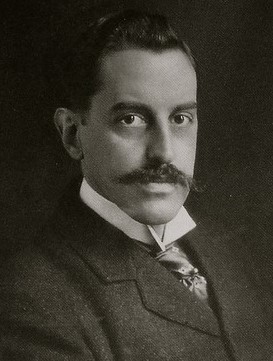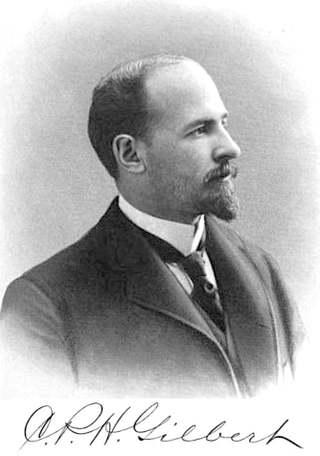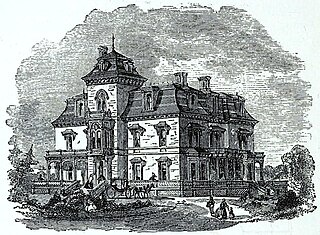
Cornelius "Corneil" Vanderbilt II was an American socialite and a member of the prominent United States Vanderbilt family.

The Vanderbilt family is an American family who gained prominence during the Gilded Age. Their success began with the shipping and railroad empires of Cornelius Vanderbilt, and the family expanded into various other areas of industry and philanthropy. Cornelius Vanderbilt's descendants went on to build grand mansions on Fifth Avenue in New York City; luxurious "summer cottages" in Newport, Rhode Island; the palatial Biltmore House in Asheville, North Carolina; and various other opulent homes. The family also built Berkshire cottages in the western region of Massachusetts; examples include Elm Court.

William Kissam Vanderbilt I was an American heir, businessman, philanthropist and horsebreeder. Born into the Vanderbilt family, he managed his family's railroad investments.

Frederick William Vanderbilt was a member of the American Vanderbilt family. He was a director of the New York Central Railroad for 61 years, and also a director of the Pittsburgh and Lake Erie Railroad and of the Chicago and North Western Railroad.

The Breakers is a Gilded Age mansion located at 44 Ochre Point Avenue, Newport, Rhode Island, US. It was built between 1893 and 1895 as a summer residence for Cornelius Vanderbilt II, a member of the wealthy Vanderbilt family.

Richard Morris Hunt was an American architect of the nineteenth century and an eminent figure in the history of American architecture. He helped shape New York City with his designs for the 1902 entrance façade and Great Hall of the Metropolitan Museum of Art, the pedestal of the Statue of Liberty, and many Fifth Avenue mansions since destroyed.

George Washington Vanderbilt II was an American art collector and member of the prominent Vanderbilt family, which amassed a huge fortune through steamboats, railroads, and various business enterprises. He commissioned the construction of a 250-room mansion, the largest privately owned home in the United States, which he named Biltmore Estate.

The Breakers was a Queen Anne style cottage designed by Peabody and Stearns for Pierre Lorillard IV and located along the Cliff Walk on Ochre Point Avenue, Newport, Rhode Island. In 1883, it was referred to as "unquestionably the most magnificent estate in Newport."

Marble House, a Gilded Age mansion located at 596 Bellevue Avenue in Newport, Rhode Island, was built from 1888 to 1892 as a summer cottage for Alva and William Kissam Vanderbilt and was designed by Richard Morris Hunt in the Beaux Arts style. It was unparalleled in opulence for an American house when it was completed in 1892. Its temple-front portico resembles that of the White House.

Alice Claypoole Vanderbilt was the wife of Cornelius Vanderbilt II and reigned as the matriarch of the Vanderbilt family for over 60 years.

Richard Howland Hunt was an American architect and member of the Hunt family of Vermont who worked with his brother Joseph Howland Hunt in New York City at Hunt & Hunt.

Charles Pierrepont Henry Gilbert was an American architect of the late-19th and early-20th centuries best known for designing townhouses and mansions.

The William K. Vanderbilt House, also known as the Petit Chateau, was a Châteauesque mansion at 660 Fifth Avenue in Midtown Manhattan, New York City, on the northwest corner of Fifth Avenue and 52nd Street. It was across the street from the Triple Palace of William Henry Vanderbilt, which occupied the entire block between 51st and 52nd Streets on the west side of Fifth Avenue.

The Cornelius Vanderbilt II House was a large mansion built in 1883 at 1 West 57th Street in Manhattan, New York City. It occupied the frontage along the west side of Fifth Avenue from West 57th Street up to West 58th Street at Grand Army Plaza. The home was sold in 1926 and demolished to make way for the Bergdorf Goodman department store.

Alva Erskine Belmont, known as Alva Vanderbilt from 1875 to 1896, was an American multi-millionaire socialite and women's suffrage activist. She was noted for her energy, intelligence, strong opinions, and willingness to challenge convention.

Beaulieu, or Beaulieu House, is a historic mansion located on Bellevue Avenue in Newport, Rhode Island built in 1859 by Federico Barreda. Subsequent owners of Beaulieu have included John Jacob Astor III, Cornelius Vanderbilt III, and his wife Grace Vanderbilt, née Grace Graham Wilson.

Ogden Goelet was an American heir, businessman and yachtsman from New York City during the Gilded Age. With his wife, he built Ochre Court in Newport, Rhode Island, his son built Glenmere mansion, and his daughter, Mary Goelet, married Henry Innes-Ker, 8th Duke of Roxburghe.
Edmund Henry Schermerhorn was an American businessman of New York's Dutch Schermerhorn family.

647 Fifth Avenue, originally known as the George W. Vanderbilt Residence, is a commercial building in the Midtown Manhattan neighborhood of New York City. It is along the east side of Fifth Avenue between 51st Street and 52nd Street. The building was designed by Hunt & Hunt as part of the "Marble Twins", a pair of houses at 645 and 647 Fifth Avenue. The houses were constructed between 1902 and 1905 as Vanderbilt family residences. Number 645 was occupied by William B. Osgood Field, while number 647 was owned by George W. Vanderbilt and rented to Robert Wilson Goelet; both were part of the Vanderbilt family by marriage.

























